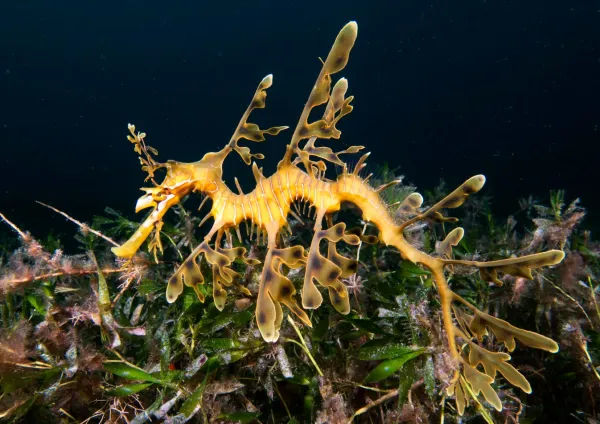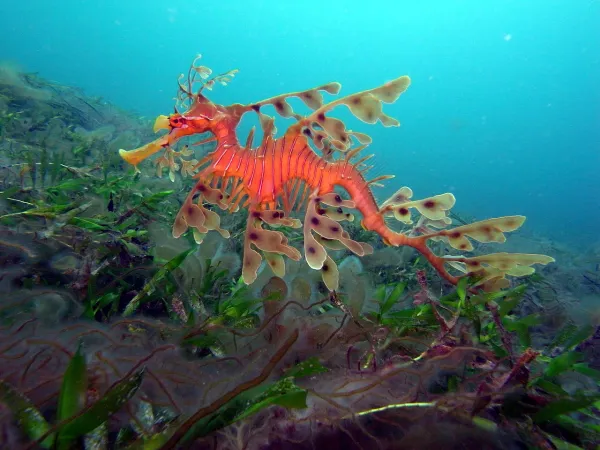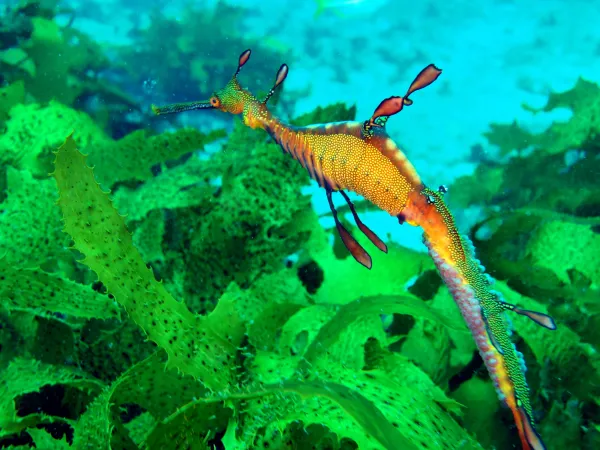Sea dragons are one of the ocean’s most spectacular and mysterious fish, closely related to seahorses and pipefish within the family Syngnathidae. Endemic to the southern and western coasts of Australia, sea dragons are known for their remarkable camouflage and unique appearance. Because of their secretive nature and remote habitats, much about them remains unknown. This article will give you a comprehensive look at what sea dragons are, their characteristics, habitat, feeding habits, reproduction, predators, and conservation status.

Physical Appearance:
Sea dragons are marine fish with elongated bodies adorned with leaf-like appendages, allowing them to perfectly mimic floating seaweed. The two recognized species are the leafy sea dragon (Phycodurus eques) and the common (weedy) sea dragon (Phyllopteryx taeniolatus).
Exceptional Camouflage:
Their leafy extensions help them blend seamlessly into kelp forests and seagrass beds, making them masters of disguise and extremely difficult for predators to spot.
Color Adaptation:
Sea dragons can change color depending on age, diet, habitat, or even stress.
Size:
They can reach up to 50 centimeters in length, with the average size around 30 centimeters.
Swimming Ability:
Sea dragons use their nearly invisible dorsal and pectoral fins to move slowly and gracefully through the water.
Social Behavior:
They are mostly solitary but can also be found in pairs or small groups. They possess a sophisticated navigation system, enabling them to travel long distances and return to their original location.
Differences from Seahorses:
Unlike seahorses, sea dragons cannot anchor themselves with their tails, making them more vulnerable to strong ocean currents.
Lifespan and Threats:
Wild populations face multiple threats from habitat loss and human activity, which put their survival at risk.
Sea dragons are found only along the temperate southern and western coasts of Australia. They typically inhabit shallow, coastal waters with sandy bottoms, rocky reefs, kelp forests, and seagrass meadows. Being sedentary animals with small home ranges, they are highly sensitive to local environmental changes.

Sea dragons are carnivorous fish. Their long, tubular snouts allow them to feed by suction, quickly ingesting small crustaceans such as amphipods, mysid shrimp, and planktonic larvae. They lack teeth and jaw structures for chewing, so they swallow prey whole. Their patient hunting strategy, combined with their camouflage, makes them highly effective predators.
Sea dragons are ovoviviparous, and like seahorses, it is the male who carries and cares for the eggs. The female lays a large number of eggs onto a brood patch located on the underside of the male’s tail. The male then seeks sheltered areas away from strong currents to protect the developing eggs until they hatch. After hatching, the young are fully independent and begin feeding on plankton.

Adult sea dragons, thanks to their excellent camouflage, are rarely preyed upon by natural predators. However, newly hatched sea dragons are vulnerable to a variety of fish and invertebrate predators, resulting in low survival rates for the young.
Main Threats:
Habitat destruction – Loss of kelp forests and seagrass beds due to coastal development and pollution.
Illegal collection – Sea dragons are sometimes caught for the aquarium trade or traditional medicine.
Natural Predation – Slow swimming speed and inability to flee make them susceptible, especially as juveniles.
Conservation Status:
Sea dragons are protected species in Australia. The International Union for Conservation of Nature (IUCN) once listed them as “Data Deficient” due to a lack of research, but ongoing efforts are improving our understanding and protection of these species. Continued monitoring and conservation actions remain essential for their survival.
Interested in learning more about rare and fascinating marine life? Check out our wildlife section for more in-depth articles!
References
IUCN, International Union for Conservation of Nature. Available at: https://www.iucn.org/en
Bibliography
Stiller, J., Wilson, N.G., Donnellan, S., Rouse, G.W. (2017). The leafy seadragon, Phycodurus eques, an emblematic species with low but structured genetic variability. Available at: https://academic.oup.com/jhered/article/108/2/152/2631585
animal tags: Sea Dragon
We created this article in conjunction with AI technology, then made sure it was fact-checked and edited by a Animals Top editor.